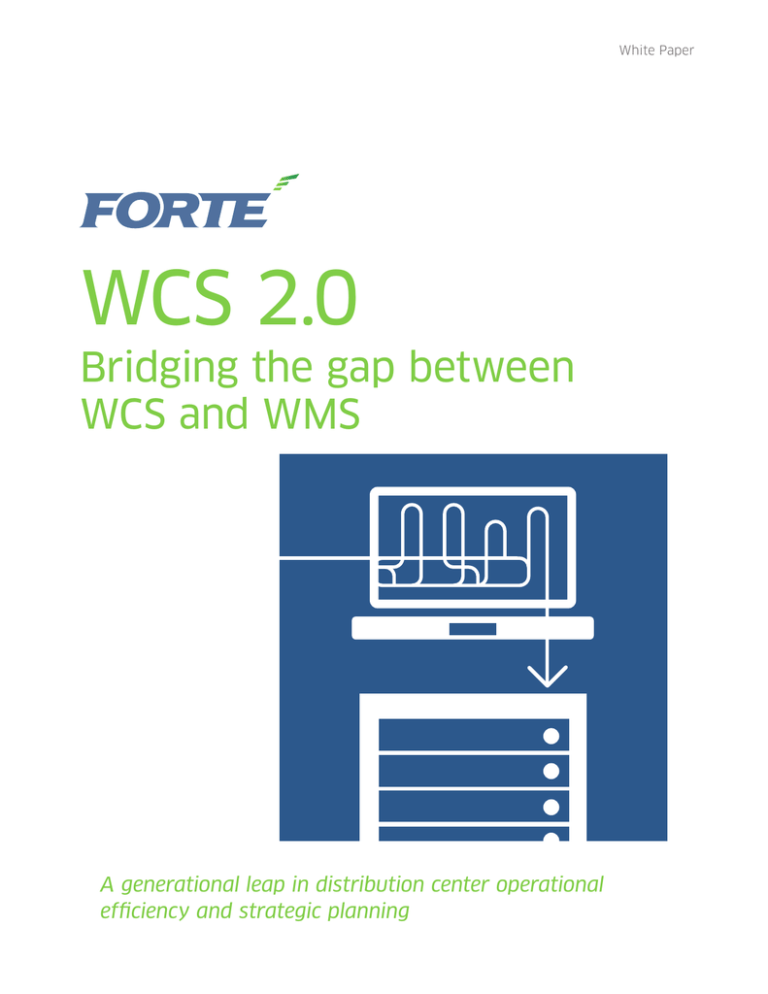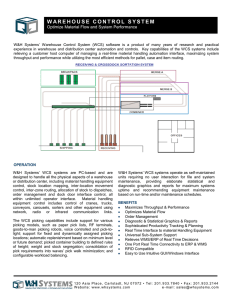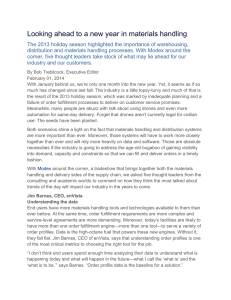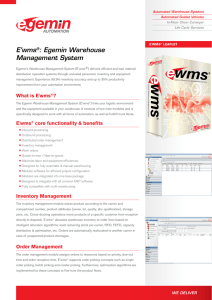WCS 2.0 Bridging the gap between WCS and WMS
advertisement

White Paper WCS 2.0 Bridging the gap between WCS and WMS A generational leap in distribution center operational efficiency and strategic planning | 2 WCS 2.0 Smart Warehouse Suite™ Introduction In the 1990s, FORTE played a key role in the development of warehouse control system (WCS) software to maximize the efficiency of material handling equipment automation in distribution center (DC) operations. Our Automation Director® WCS software provided reliable conveyor and sortation control for the directional routing of product throughout the DC while communicating with the warehouse management system (WMS) or enterprise resource planning (ERP) system to drive the optimal utilization of both human and automated operational resources. WCS software determined the most efficient product flow and communicated directives to the equipment controllers to achieve the desired results. As volumes and velocities increased, WCS evolved to keep pace with collecting and analyzing data to coordinate material handling systems and subsystems. Today, FORTE’s new WCS 2.0 Smart Warehouse Suite is capable of far more than efficient management of controls systems, material handling equipment and mechanical systems that comprise the automated DC. Embedded with intelligence that truly makes it smart, FORTE’s WCS 2.0 provides managers with holistic operational awareness along with a new way of harnessing information to more insightfully and effectively manage the DC in both the immediate and longer terms. Context: A Brief History of WMS/WCS For more than 30 years, WMS applications have consistently evolved to better support DC operators as they have adapted to a major thrust among manufacturers, distributors and retailers to reduce supply chain inventory. To the DC operator, reduced inventory translates to smaller, more frequent receipts and outbound orders and a resulting shift from pallet/ case picks to layer, case and split-case picks and higher labor costs. Manually operated and tied to a mainframe computer, the WMS of the 1980s was introduced as the back end of an inventory/purchase order/outbound order management system and was incapable of providing the functionality needed to support the more complex processes needed for DCs to operate effectively within this new environment. Subsequently, two cornerstones of WMS functionality were implemented to respond to changing business conditions: 1.Real-time tracking (1980s) — The ability to review all distribution processes in real time — receive, put away, wave, replenish, pick, pack and ship orders — enabled visibility to the interdependence among all DC tasks. Instead of system updates occurring in batches on scheduled intervals (hourly), the completion of every task was immediately reflected in the WMS. | 3 WCS 2.0 Smart Warehouse Suite™ 2.Task management (1990s) — With improved visibility to DC operations, the WMS took the next logical step to assist in managing activities on the floor by assessing priorities in real time and assigning the task to the next available resource. While these first instances of warehouse automation further improved accuracy and efficiency, they prompted the continued development of increasingly complex WMS functionality throughout the decade. The advent of e-commerce during the dotcom boom at the turn of the century and its subsequent foothold in today’s marketplace has forced DC operations to add “direct-toconsumer” shipping into the distribution mix. As a result, the quantity and complexity of the transactions being processed within the WMS increased significantly, which invariably led to its declining responsiveness. The increasing application of warehouse automation and its integration into the WMS only exacerbated the problem. Enter the WCS, a software application sitting between the WMS or ERP enterprise-level system and the automated materials handling equipment (MHE). Its task is to control and synchronize the storage, picking, conveyance, sorting, value-added services (VAS), etc., of automated order fulfillment. The WCS determines the best way to route materials through the automated systems; provides real-time control to re-optimize orders as required; and communicates with the WMS, providing visibility into warehouse activities. In other words, the WCS efficiently manages the second-by-second daily operations of the DC facility through a real-time data exchange with the WMS to coordinate and optimize workflows and equipment usage for maximum productivity. Responding to a Changing Paradigm A confluence of business environment and marketplace forces is reshaping and broadening the role of WCS. Certainly, it must augment or fill in the functionality gaps of the existing WMS. In some cases, it simulates enterprise-wide warehouse software functions — i.e., a comprehensive business application enhancing warehouse operations by including metrics and analytics, visibility, monitoring, oversight, etc., — but with a higher level of efficiency and at a lower total cost than a traditional WMS. Finally, the WCS must provide comprehensive, actionable intelligence (both in a micro and macro sense) for the immediate tactical objective of maximizing order throughput and the longer-term strategic planning of facility and network optimization. So what are these forces driving the increasing functionality of WCS and its widespread application? Even before the explosion of e-commerce, the nature and complexity of product distribution and order fulfillment had been changing. Pallet shipments were replaced with cases and split-cases; and now eaches are overwhelmingly predominant. Customer requirements for VAS and timely delivery have grown immensely and must be satisfied to remain competitively viable. Management expects continuous improvement to provide higher throughput at quicker speed and with greater accuracy, including 24-hour and even sameday delivery. Finally, competitive pressures to lower prices and further reduce costs make automation a pragmatic alternative to expensive labor. Because traditional DC’s were designed solely for retail store fulfillment, they are now being pushed to their limits to accommodate multi-channel fulfillment processes. The best way to drive automated solutions to handle this ever-increasing complexity — and still achieve the lowest total cost system and optimum labor balance — is a powerful and intelligent WCS. | 4 WCS 2.0 Smart Warehouse Suite™ Next Generation WCS 2.0 Smart Warehouse Suite Software To date, the WCS has primarily served as an interface between the WMS and the automated MHE systems. FORTE’s Automation Director has proven to be a reliable and effective means of integration across all islands of automation in a DC. But this traditional conveyor and sortation control and high-speed communication broker is now only one component in a much more robust response to the needs of the contemporary DC operator. The Smart Warehouse Suite — WCS 2.0 — is a truly intelligent, next generation WCS. WCS 2.0 is a lean and agile platform with comprehensive functionality to fill the gaps between conventional WMS and WCS capabilities. This software technology is completely and cost-effectively configurable to the user’s needs, eliminating expensive and tedious WMS customization, integration services and further software investment. Software as a Service (SaaS) and Cloud services are excellent examples of how this type of configure-to-order technology model is presently being implemented. Both adopt a payfor-what-you-need, à la carte flexibility. This allows the users to select only the specific services and applications that meet their current needs while allowing them to add low-cost capabilities as required. It is Web and mobile connected, providing instantaneous visibility of DC status, performance and alerts of potential bottlenecks and notification of other potential thresholds to permit a balanced response. Plus, it has an immense storage capacity and analysis capability for processing statistical data into actionable information for the development of tactical and strategic plans. For many DC managers, investment in automation combined with the Smart Warehouse Suite will provide a better return on investment (ROI) with lower total cost of ownership than investments in other WMS solutions or major modifications to legacy systems. In summary, FORTE’s WCS 2.0 Smart Warehouse Suite adds new levels of intelligence and nimbleness to DC operations. • It can extend the utility of legacy systems or augment WMS functionality without undue complexity or expense. • This lean, agile, platform-independent application is quickly and cost-effectively configurable to the end user’s needs. The software readily adapts to DC processes and practices, not vice versa. • At its core, it is modular, scalable and service based, giving the user the flexibility to obtain the precise mix of software technology needed to accomplish the mission. • Its simplified operating, upgrade and configuration processes increase business agility at minimum cost. • It provides actionable intelligence through seamless real-time communications to support operational and strategic planning. It also presents decisional information to determine the implications of an action and its effects on the distribution system. | 5 WCS 2.0 Smart Warehouse Suite™ Individual components comprising the WCS 2.0 Smart Warehouse Suite include: Warehouse Director™ — Provides core warehouse management functionality as well as a platform to extend the capabilities of existing systems. Warehouse Director • Receiving • Inventory tracking • Put away • Picking • Packing Warehouse Director • Shipping • Returns processing • Quality inspection • Wave optimization Automation Director Insert screen shot here Automation Director® — An operational control system managing the demands of any DC’s fulfillment requirements, from the basic automation of manual processes through advanced material handling systems. • Intelligent sortation logic • Dynamic routing • Inline compliance labeling Automation Director • Inline scale interaction • Touchscreen-enabled operator interface Insert screen shot here • Data logging • System diagnostics • Non-standard/seasonal operations | 6 WCS 2.0 Smart Warehouse Suite™ Operations Director™ — Provides event monitoring, incident management and visibility to the effectiveness of the delivery systems with detection and correction of system inefficiencies. Operations Director Insert screen shot here • Operational health monitoring • Predictive issue and maintenance detection Operations Director • Event management and notification • Maintenance management Insert screen shot here • Change management controls • Dedicated technical support • System surveillance management and proactive issue resolution Intelligence Director Insert screen shot here Intelligence Director™ — Provides performance metrics and predictive analytics for comprehensive operational intelligence. Validates current operational effectiveness while providing guidance for operational improvements. • Operational intelligence • Scenario and system simulation • Performance dashboard • Key performance indicators (KPIs) measurement and monitoring • Reporting center Integration Director Integration Director™ — Provides a single point of integration across all islands of automation, eliminating the need to develop multiple, complex integrations within the WMS as additional automation is introduced. Further, it allows real-time sharing and dissemination of information between each WCS 2.0 component. • High-speed, multi-directional communication broker • Message decomposition and translation for streamlined interface with other systems • Uses XML or other standard and/or preferred message formats • Leverages multiple communication protocols Insert screen shot here Integration Director Insert screen shot here | 7 WCS 2.0 Smart Warehouse Suite™ Summary Originally designed for less complex distribution operations, WMS and enterprise warehouse modules are sometimes inadequate in their ability to manage the volume of activity and velocity of the automated DC, or nimbly adapt to its changing conditions without costly software modifications. WCS applications have bridged these gaps, serving effectively as “direct and control” middleware between the host system (i.e., WMS or ERP) and the automated MHE and associated subsystems network. In short, there are three primary reasons to integrate WCS 2.0: 1.Avoid over-investing in WMS. In many cases, the full utilization of WMS functionality is unnecessary and may even jeopardize performance. Instead, the integration of WCS 2.0 represents a low-cost investment with the promise of dramatic performance improvements. 2.Don’t risk costly WMS customization. Modifications to legacy WMS systems are fraught with challenges. Most often, code changes require lengthy testing and validation before they can become operational; often costly conflicts are discovered only after going live. In addition, every change to the code of a legacy system further complicates its codebase and subsequent upgrade path in the future. On the contrary, WCS 2.0 can provide the needed customization without risking the current (or future) condition of the legacy system. 3.Access to real-time reporting. On its own, the WMS is simply incapable of providing the degree of real-time, actionable intelligence that can be provided via WCS 2.0. The superior visibility delivered by WCS 2.0 puts metrics, analytics and the full operational dashboard at the DC manager’s fingertips. With the introduction of FORTE’s WCS 2.0 Smart Warehouse Suite, DC managers now have the benefits of intelligent technology within their grasp. Not only does WCS 2.0 drive the optimal use of automation and achieve the most productive workflow balance possible, it also gives the user unprecedented decisional information and operational flexibility. Its diagnostics make “thoughtful” adjustments to the automation system in real time for assured operating efficiency. It provides visibility, issues alerts, continuously and instantaneously communicates with the WMS and other WCS software constituents, etc. Its modularity and configurability make it a lean and agile platform that saves the end user money and enables them to tailor the software to their precise needs. And when combined with the right analytical tools, WCS 2.0 can provide informed and insightful intelligence for effective strategic planning. FORTE’s WCS 2.0 Smart Warehouse Suite meets the needs of fast-growing companies whose supply chain management organizations seek intelligent, innovative solutions at the lowest total cost of implementation and ownership. | 8 WCS 2.0 Smart Warehouse Suite™ Why FORTE Single-Source Accountability Whether we’re helping you develop a strategic plan, design and build a distribution facility, or optimize a distribution operation through performance metrics and analytics, FORTE provides a true single point of contact responsible for the complete performance of your distribution network. No finger pointing. No fragmentation of responsibility. No multiple suppliers for technical support. You have performance goals, and it’s our job to make sure they’re met on an ongoing basis. Total Objectivity We don’t manufacture equipment. We don’t develop WMS software. We don’t have commercial arrangements with any suppliers for expected volumes of business. We’re simply interested in delivering the most efficient distribution solutions at the lowest total cost. Our client-side service approach means our only allegiance is to our customers. So with every engagement, you know we’ll choose the most appropriate level and blend of technologies integrated into an effective operational system. Expertise Our team is deeply rooted in the hands-on implementation of distribution center design and warehouse automation. FORTE’s engineers and technicians integrate today’s best practices in supply chain management and distribution center operations while developing nextgeneration technologies. As a result, our solutions employ the best combination of practical advice, data-driven analysis and technology-enabled systems. With FORTE, you get: • More accountability than a consultant • More experience than a systems integrator • More objectivity than a manufacturer That’s why the world’s fastest-growing companies are making distribution their FORTE. 274-WP-1003 MAIN (513) 398.2800 FAX (513) 398.2837 6037 Commerce Court / Mason, Ohio 45040 / FORTE-Industries.com








